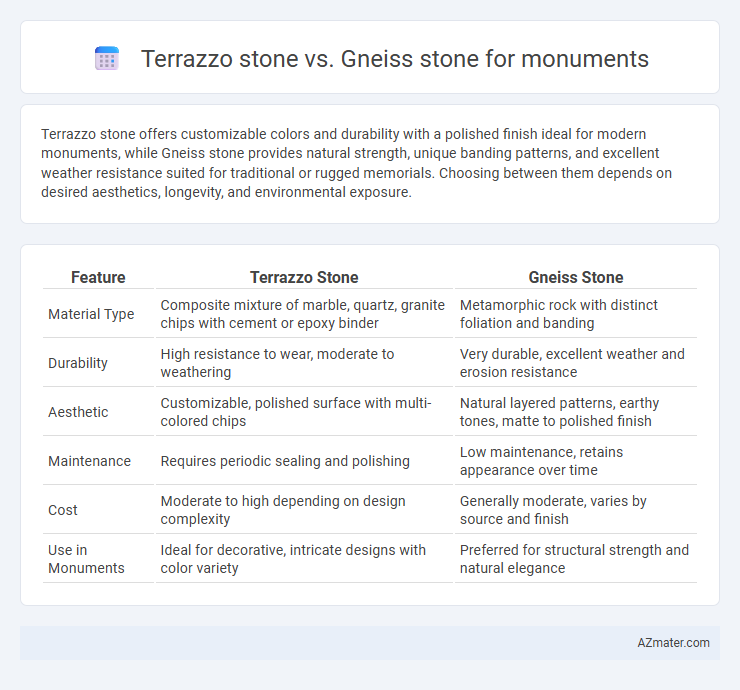Terrazzo stone offers customizable colors and durability with a polished finish ideal for modern monuments, while Gneiss stone provides natural strength, unique banding patterns, and excellent weather resistance suited for traditional or rugged memorials. Choosing between them depends on desired aesthetics, longevity, and environmental exposure.
Table of Comparison
| Feature | Terrazzo Stone | Gneiss Stone |
|---|---|---|
| Material Type | Composite mixture of marble, quartz, granite chips with cement or epoxy binder | Metamorphic rock with distinct foliation and banding |
| Durability | High resistance to wear, moderate to weathering | Very durable, excellent weather and erosion resistance |
| Aesthetic | Customizable, polished surface with multi-colored chips | Natural layered patterns, earthy tones, matte to polished finish |
| Maintenance | Requires periodic sealing and polishing | Low maintenance, retains appearance over time |
| Cost | Moderate to high depending on design complexity | Generally moderate, varies by source and finish |
| Use in Monuments | Ideal for decorative, intricate designs with color variety | Preferred for structural strength and natural elegance |
Introduction to Terrazzo and Gneiss Stones
Terrazzo stone is a composite material made from chips of marble, quartz, granite, or glass set in cement or epoxy resin, prized for its durability and decorative versatility in monuments. Gneiss stone, a natural metamorphic rock with distinct banded textures and high resistance to weathering, offers a robust and elegant option for outdoor monuments. Both materials provide unique aesthetic and structural qualities, with terrazzo showcasing customizable patterns and gneiss emphasizing natural stone beauty and strength.
Overview: What is Terrazzo Stone?
Terrazzo stone is a composite material consisting of marble, quartz, granite, or glass chips embedded in a cement or epoxy binder and polished to a smooth, durable finish ideal for monuments. Its customizable color and pattern options offer aesthetic versatility compared to the naturally occurring banded texture of gneiss stone. Terrazzo's non-porous surface and resistance to weathering make it a practical and low-maintenance choice for long-lasting memorials.
Overview: What is Gneiss Stone?
Gneiss stone is a high-grade metamorphic rock characterized by its distinctive banded texture and coarse-grained mineral composition, typically including quartz, feldspar, and mica. Known for its durability and resistance to weathering, gneiss is commonly used in monuments and construction where long-lasting material is essential. Its unique foliation patterns provide an aesthetically appealing appearance that enhances the visual impact of memorial structures.
Aesthetic Differences: Terrazzo vs Gneiss
Terrazzo stone offers a vibrant and customizable aesthetic with its composite of marble, quartz, and glass chips embedded in cement or resin, creating intricate patterns and a polished finish ideal for modern monuments. Gneiss stone features a natural, banded texture with earthy tones and varied mineral grains, providing a more rugged and timeless look that suits classical or nature-inspired memorials. The choice between Terrazzo and Gneiss hinges on a preference for Terrazzo's colorful, engineered design versus Gneiss's organic, textured elegance.
Durability Comparison for Monument Use
Terrazzo stone offers high durability with excellent resistance to wear and weathering, making it ideal for both indoor and outdoor monuments subjected to foot traffic and environmental exposure. Gneiss stone, known for its metamorphic strength and dense crystalline structure, provides exceptional hardness and resistance to erosion, ensuring long-lasting monument preservation in harsh climates. When comparing durability for monument use, gneiss generally outperforms terrazzo in terms of structural integrity over decades, while terrazzo excels in aesthetic longevity and surface resilience.
Weather Resistance: Terrazzo vs Gneiss Stone
Terrazzo stone, composed of marble, quartz, granite chips bound with cement or epoxy, offers moderate weather resistance but may require sealing to prevent water infiltration and surface wear over time. Gneiss stone, a high-grade metamorphic rock with pronounced foliation and mineral banding, exhibits superior durability against harsh weather conditions, including freeze-thaw cycles and acid rain, making it more suitable for long-lasting monuments exposed to outdoor elements. The inherent density and low porosity of Gneiss contribute to its enhanced resistance to weathering compared to Terrazzo's composite structure.
Maintenance and Longevity
Terrazzo stone offers superior resistance to stains and requires minimal maintenance due to its sealed surface, making it ideal for high-traffic monuments. Gneiss stone, known for its natural durability and weather resistance, can endure harsh environmental conditions with less frequent upkeep, but it may need periodic sealing to prevent erosion. Both materials provide long-lasting monument solutions, though terrazzo's engineered composition ensures consistent durability while gneiss offers a more natural aesthetic with robust longevity.
Cost Analysis: Terrazzo vs Gneiss
Terrazzo stone generally offers a more cost-effective option compared to Gneiss stone for monument construction, with lower material and installation expenses due to its composite nature and ease of molding. Gneiss stone, being a durable and natural metamorphic rock, tends to have higher costs related to quarrying, cutting, and transportation, making it more expensive upfront. Long-term maintenance expenses for terrazzo are typically lower due to its resistance to stains and cracks, whereas Gneiss requires periodic sealing and care to maintain its aesthetic and structural integrity.
Environmental Impact and Sustainability
Terrazzo stone, composed of recycled glass, marble chips, and cement, offers a more sustainable and eco-friendly option due to its use of repurposed materials and lower carbon footprint compared to natural stones. Gneiss stone, a durable metamorphic rock, requires extensive quarrying, resulting in significant environmental disturbance and higher energy consumption during extraction and processing. Choosing terrazzo for monuments supports waste reduction and resource efficiency, making it a preferable choice for environmentally conscious projects.
Final Recommendations for Monument Construction
Terrazzo stone offers superior aesthetic versatility and durability, making it ideal for intricate monument designs and long-lasting outdoor exposure. Gneiss stone provides exceptional natural strength and weather resistance, suitable for traditional monuments requiring robust structural integrity. For monument construction, Terrazzo is recommended when design flexibility and polished finishes are priorities, while Gneiss is preferred for heavy-duty, enduring monuments in harsh environmental conditions.

Infographic: Terrazzo stone vs Gneiss stone for Monument
 azmater.com
azmater.com